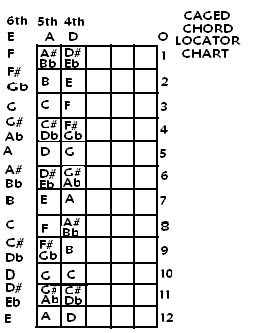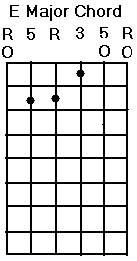|

Custom Search
Learning the CAGED Guitar Method Frees your Chord Knowledge!
You may have heard the term before. But what is the CAGED guitar method? The CAGED Method is a simple approach to learning a lot of chords. A Little Easy Chord TheoryLet's look at some basic information about chords. A chord is a combination of specific notes from a scale. The CAGED guitar method is based on notes from the major scale. You probably already know the major scale. Do, ri, mi, fa, so, la, ti, do. That looks familiar doesn't it? For the chords in the CAGED Method we are going to be using a combination of do,mi and so. Do will be called the root, mi the 3rd and so is the 5th. The root, 3rd and 5th may occur more than once in the same chord. It's okay if that happens. Some people think that a chord shape is the same thing as a guitar chord. That really isn't true. Remember that a major chord is a combination of do, mi and so ( root, 3rd and 5th ). A guitar shape is a particular pattern that you put your fingers in on the fretboard. Sometimes you can put your fingers in two different places using the same shape and get the same sound. Take a look at this example.
Okay, now that we know the difference between chords and chord shapes, we're going to look at 5 different chord shapes. If these chords were all played on frets 1-3 they would be the chords C, A, G, E, and D. That's where we get the term, CAGED guitar method.
How To Use ThemAs mentioned earlier there's a difference between chords and chord shapes. With the CAGED guitar system each of the 5 chord shapes can be used to play the same chord at 5 different places on the fingerboard. Let's start with a C major chord and see how to play it with all of the 5 chord shapes. Look at where your fingers are in relation to the nut. This is very important. The reason that it's important is because our 1st finger will have to take the place of the nut on some chords. Let's start with a C chord.
Use the C shape to play a C chord at the 1st fret. So far so good. Okay, to play a C chord using the A shape place your 1st finger across the 3rd fret from the 1st to the 5th string. Now fret the 2nd, 3rd, and 4th strings at the 5th fret. This is a C chord using the A shape. Here's the giveaway. To figure out the chord name of a particular chord shape look at which note is the root. With our C chord with the A shape the root is on the 5th string at the 3rd fret. As you may have guessed, it's a good idea to learn the names of the notes on the strings. Especially the 5th and 6th strings. You use the same process for the G shape. Make your G shape at the 8th fret using the 2nd, 3rd and 4th fingers. Now bar across the 5th fret with your 1st finger. That's a heck of a stretch isn't it? This should make it easier. Don't fret and play the 1st string. It is the same note as the 6th string 2 octaves higher ( an octave is the distance from do to do ). For the C chord with an E shape, play a bar with your 1st finger at the 8th fret and play an E chord shape with fingers 2,3, and 4. Using the D shape will be a little different. Your root will be on the 4th string at the 10th fret. Then place the rest of your fingers in the D shape beginning at the 12th fret. Moving Them Around
You can repeat this process with your other chord forms. Play an A chord with the A shape on the second fret. Now go to the 5th fret and play the G shape. While you're at the 5th fret bar across it and use the E shape. You'll move up to the 7th fret on the 4th string to use your D shape. Here's how the C shape figures into it. Bar across the 1st-3rd strings at the 9th fret. With fingers 2,3, and 4 play a C shape. TADA! You've just played an A chord using the C chordshape. You can play any major chord using the CAGED guitar method. The most important things to know are; 1) How to play the 5 chord forms,2) Where's the root of the chord, and 3) how to play barre chords. The Caged chord locator can help you figure out where each chord is found. 
It takes a little work but it pays off in a big way. If you want to dig even deeper into CAGED chords, check out Ernie Hawkins great tutorials. You can read my review here Return to learn-fingerstyle-guitar.com .
|










